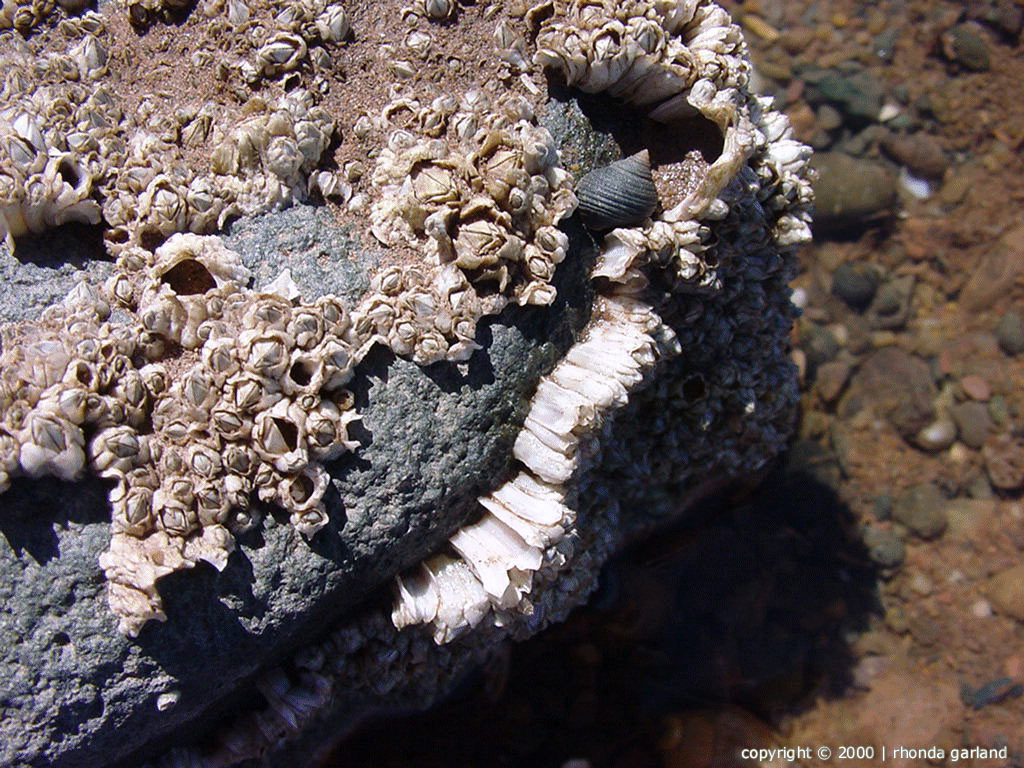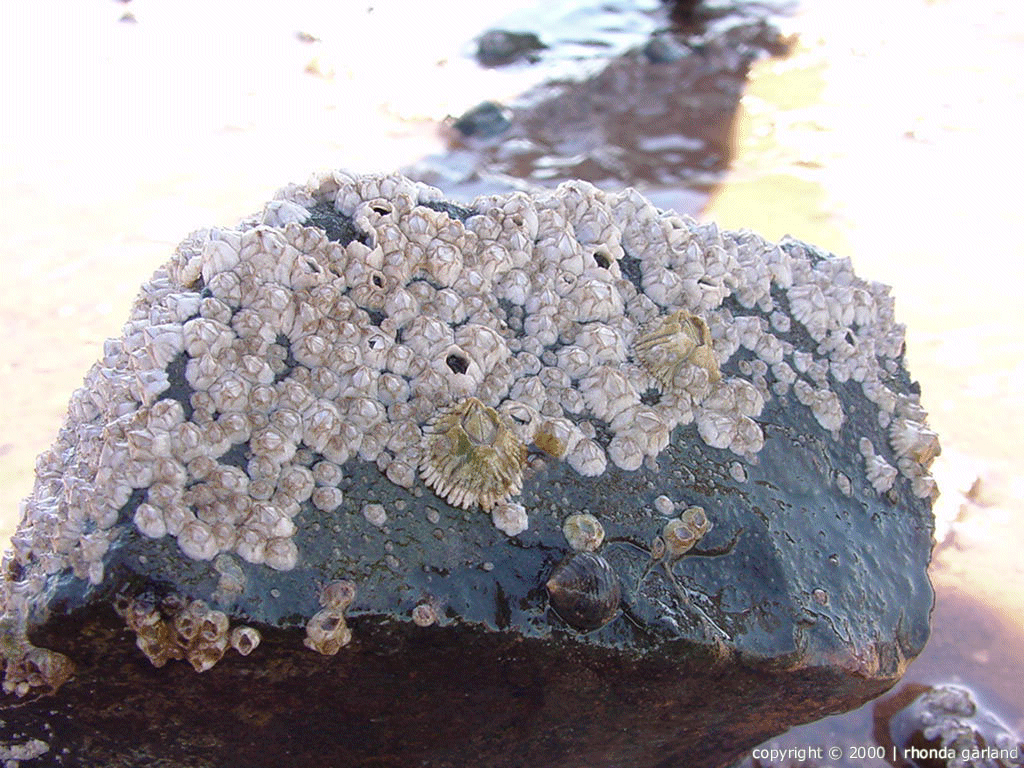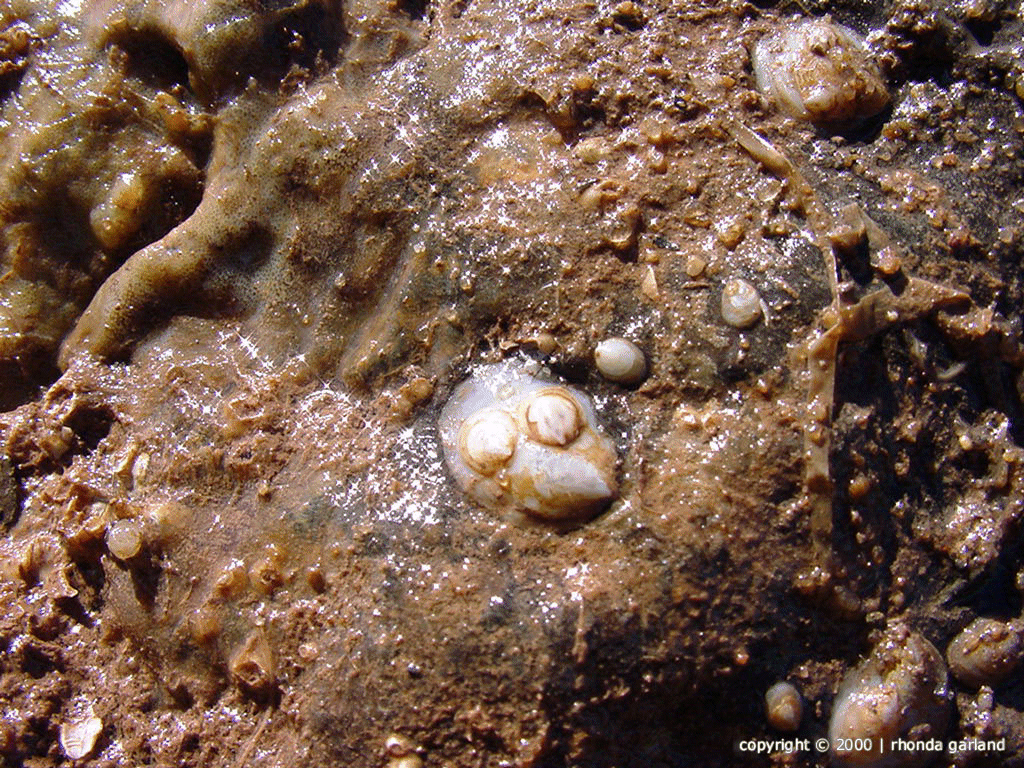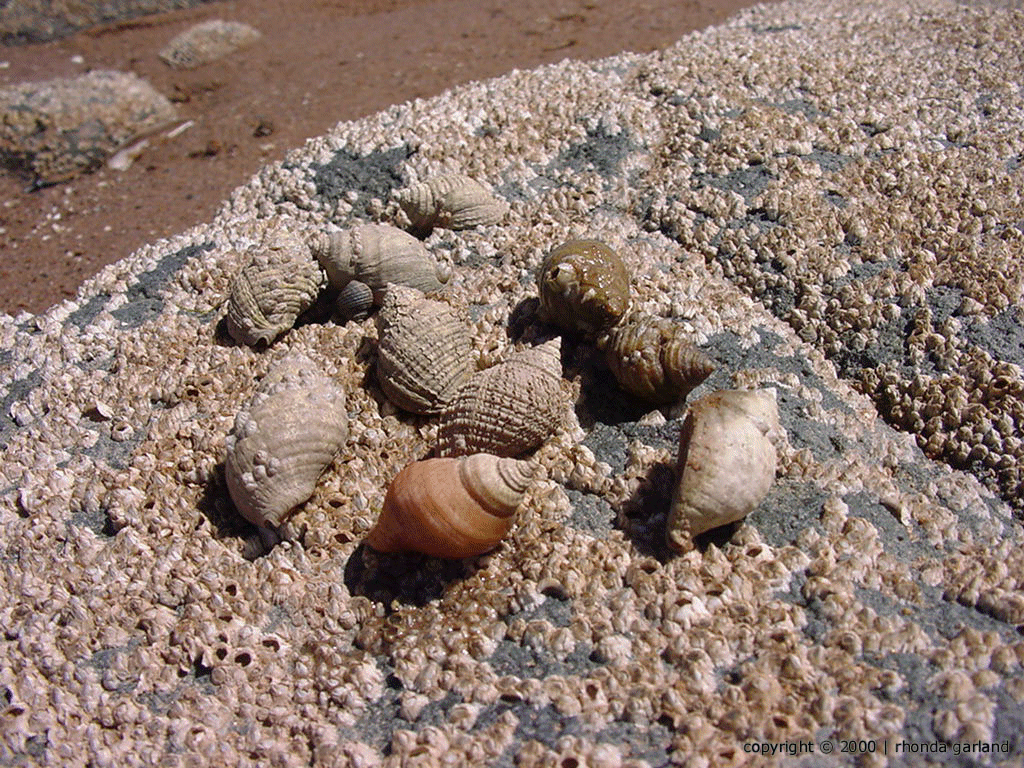A variety of animals inhabit the intertidal zone.
 Most of the rocks on this beach are literally covered with colonies of barnacles. On
some rocks there is limited space for growth in width and instead, the barnacles have grown upward and appear rather
"tall". Although barnacles produce "shells" like mollusks, they are
not related. Barnacles are crustaceans like lobster and shrimp. Unlike their more motile cousins, however,
these tiny shrimp-like organisms permanently attach themselves to a substrate (rock, boat, etc.) and secrete a series
of calcareous plates for protection against predators and dessication at low tide. The shell can be opened and closed by 4
calcareous plates attached to the muscles of the organism.
Most of the rocks on this beach are literally covered with colonies of barnacles. On
some rocks there is limited space for growth in width and instead, the barnacles have grown upward and appear rather
"tall". Although barnacles produce "shells" like mollusks, they are
not related. Barnacles are crustaceans like lobster and shrimp. Unlike their more motile cousins, however,
these tiny shrimp-like organisms permanently attach themselves to a substrate (rock, boat, etc.) and secrete a series
of calcareous plates for protection against predators and dessication at low tide. The shell can be opened and closed by 4
calcareous plates attached to the muscles of the organism.

The "open" barnacles in the photo at the right are actually
dead (probably eaten by dog whelks); the plates are always closed when exposed to the atmosphere. If the
barnacles are placed in a pan of water, some of the shells will open and the modified lags called cirri will extend. The
cirri wave back and forth to create water currents that draw small organisms and food particles into the shell where they are eaten (i.e., they are filter feeders).

The plate on the lower surface of the slipper limpet gives the upside-down shell the appearance of a slipper. Slipper limpets are often
found attached to one another, forming a stack (see centre of photo on the left). Slipper limpets are able to change sex. Young limpets are males and
change into females as they become older. Females do not change into males. In a stack of limpets, the older animals at
the base are females, the young ones at the top are males and the ones in between are males changing into females.
 There are 3 species of periwinkles that may be found on this beach. Periwinkles are relatively small snails (the largest species only gets as long as 3 cm) which have a more
rounded shape compared to the whelks. All three species belong to the same genus Littorina and are strict vegetarians.
They eat microscopic algae growing on the rocks and seaweed. They themselves are eaten by a variety of organisms
including bottom dwelling fish, seagulls, whelks and even people. Although they are not common fare on the table here in
Nova Scotia today, they are a popular food item in Europe and old Mic Mac campsites that have been excavated are
often found to be littered with periwinkle shells.
There are 3 species of periwinkles that may be found on this beach. Periwinkles are relatively small snails (the largest species only gets as long as 3 cm) which have a more
rounded shape compared to the whelks. All three species belong to the same genus Littorina and are strict vegetarians.
They eat microscopic algae growing on the rocks and seaweed. They themselves are eaten by a variety of organisms
including bottom dwelling fish, seagulls, whelks and even people. Although they are not common fare on the table here in
Nova Scotia today, they are a popular food item in Europe and old Mic Mac campsites that have been excavated are
often found to be littered with periwinkle shells.
 Whelks are relatively large snails with a spindle-shaped shell. The species most commonly found on rocks in the
inter-tidal zone is the Dog Whelk (Thais lapillus). It can be 4 cm or more in length and comes in a variety of colours:
white, yellow, orange, purple and brown. They may or may not have dark bands superimposed on the basic body colour and
their shells may be rough or smooth (both are shown in photo at left). They are strict carnivores, preying on barnacles, periwinkles and mussels. Their
method of attack varies depending on their prey. In the case of barnacles, they push the plates of the shell slightly apart
and inject a toxic compound, purpurin, into the shell. This causes the muscles of the barnacle to relax and the whelk opens
the shell and eats the barnacle. In the case of periwinkles and mussels, the whelk secretes an acid which softens the shell
and then scrapes a hole through the shell with its radula. Indians extracted purpurin from whelks for use as a
purple dye.
Whelks are relatively large snails with a spindle-shaped shell. The species most commonly found on rocks in the
inter-tidal zone is the Dog Whelk (Thais lapillus). It can be 4 cm or more in length and comes in a variety of colours:
white, yellow, orange, purple and brown. They may or may not have dark bands superimposed on the basic body colour and
their shells may be rough or smooth (both are shown in photo at left). They are strict carnivores, preying on barnacles, periwinkles and mussels. Their
method of attack varies depending on their prey. In the case of barnacles, they push the plates of the shell slightly apart
and inject a toxic compound, purpurin, into the shell. This causes the muscles of the barnacle to relax and the whelk opens
the shell and eats the barnacle. In the case of periwinkles and mussels, the whelk secretes an acid which softens the shell
and then scrapes a hole through the shell with its radula. Indians extracted purpurin from whelks for use as a
purple dye.

The whelk lays its eggs in capsules which may be seen on the sides of (or sometimes beneath) rocks. The egg
capsules are yellowish, vase-shaped and about 1 cm high. Each capsule contains several hundred eggs (most of which are
unfertilized). When the fertilized eggs hatch, the young larvae feed on the unfertilized eggs.
Other snails: Several other snails can also be seen at this sites. Mud Dog Whelks or Mud Snails (Nassarius obsoletus)
are common on the mud flats. These are the same mud snail we saw at the salt marsh on our first field trip. You may also
find the empty shells of larger snails on the beach. These are mostly sub-tidal species whose empty shells get washed up
on the beach once they die. Most of these empty shells are moon snails (Lunatia heros). The shells are rounded and up to
12 cm in diameter. Moon snails are carnivores and tunnel through the mud looking for clams. When a clam is found, it
holds it with its foot and scrapes a hole in the shell with its radula. Moon snails are edible but they do concentrate the same
toxins that cause paralytic shell fish poisoning.
 Most of the rocks on this beach are literally covered with colonies of barnacles. On
some rocks there is limited space for growth in width and instead, the barnacles have grown upward and appear rather
"tall". Although barnacles produce "shells" like mollusks, they are
not related. Barnacles are crustaceans like lobster and shrimp. Unlike their more motile cousins, however,
these tiny shrimp-like organisms permanently attach themselves to a substrate (rock, boat, etc.) and secrete a series
of calcareous plates for protection against predators and dessication at low tide. The shell can be opened and closed by 4
calcareous plates attached to the muscles of the organism.
Most of the rocks on this beach are literally covered with colonies of barnacles. On
some rocks there is limited space for growth in width and instead, the barnacles have grown upward and appear rather
"tall". Although barnacles produce "shells" like mollusks, they are
not related. Barnacles are crustaceans like lobster and shrimp. Unlike their more motile cousins, however,
these tiny shrimp-like organisms permanently attach themselves to a substrate (rock, boat, etc.) and secrete a series
of calcareous plates for protection against predators and dessication at low tide. The shell can be opened and closed by 4
calcareous plates attached to the muscles of the organism.




